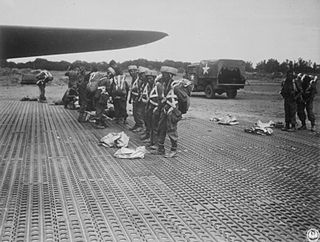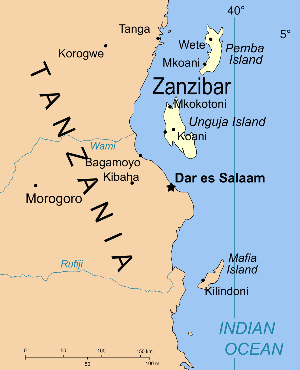
Zanzibar is an insular semi-autonomous province which united with Tanganyika in 1964 to form the United Republic of Tanzania. It is an archipelago in the Indian Ocean, 25–50 kilometres (16–31 mi) off the coast of the mainland, and consists of many small islands and two large ones: Unguja and Pemba Island. The capital is Zanzibar City, located on the island of Unguja. Its historic centre, Stone Town, is a World Heritage Site.

Abeid Amani Karume was the first President of Zanzibar. He obtained this title as a result of a revolution which led to the deposing of Sir Jamshid bin Abdullah, the last reigning Sultan of Zanzibar, in January 1964. Three months later, the United Republic of Tanzania was founded, and Karume became the first Vice President of the United Republic with Julius Nyerere of Tanganyika as president of the new country. He was the father of Zanzibar's former president, Amani Abeid Karume.
Popobawa, also Popo Bawa, is the name of an evil spirit or shetani, which is believed by residents of Zanzibar to have first appeared on the Tanzanian island of Pemba. In 1995, it was the focus of a major outbreak of mass hysteria or panic which spread from Pemba to Unguja, the main island of the Zanzibar Archipelago, and across to Dar es Salaam and other urban centres on the East African coast.

Seif Sharif Hamad was a Tanzanian politician who served as the First Vice President of Zanzibar and as Party Chairman of ACT Wazalendo. He was the secretary-general of the opposition Civic United Front (CUF) party and First Vice President of Zanzibar until 18 March 2019 when he announced his resignation from CUF and joined Alliance for Change and Transparency. He was given an ACT Wazalendo card number One, and he also won the party nomination for the 2020 presidential candidate for Zanzibar.

The Zanzibar Revolution occurred in 1964 and led to the overthrow of the Sultan of Zanzibar and his mainly Arab government by local African revolutionaries. Zanzibar was an ethnically diverse state consisting of a number of islands off the east coast of Tanganyika, which had been granted independence by Britain in 1963. In a series of parliamentary elections preceding independence, the Arab minority succeeded in retaining the hold on power it had inherited from Zanzibar's former existence as an overseas territory of Oman. Frustrated by under-representation in Parliament despite winning 54 per cent of the vote in the July 1963 election, the African Afro-Shirazi Party (ASP) early in the morning of 12 January 1964, led by John Okello, the (ASP) youth leader of the Pemba branch, mobilised around 600–800 revolutionaries on the main island of Unguja whom he had mobilized months earlier. Having overrun the country's police force and appropriated their weaponry, the insurgents proceeded to Zanzibar Town, where they overthrew the Sultan and his government. Reprisals against Arab and South Asian civilians on the island followed; the resulting death toll is disputed, with estimates ranging from several hundred to 20,000. The moderate ASP leader Abeid Karume became the country's new president and head of state.
John Gideon Okello was a Ugandan revolutionary and the leader of the Zanzibar Revolution in 1964. This revolution overthrew Sultan Jamshid bin Abdullah and led to the proclamation of Zanzibar as a republic.

The Sultanate of Zanzibar, also known as the Zanzibar Sultanate, was a state controlled by the Sultan of Zanzibar, in place between 1856 and 1964. The Sultanate's territories varied over time, and at their greatest extent spanned all of present-day Kenya and the Zanzibar Archipelago off the Swahili Coast. After a decline, the state had sovereignty over only the archipelago and a 16-kilometre-wide (10 mi) strip along the Kenyan coast, with the interior of Kenya constituting the British Kenya Colony and the coastal strip administered as part of that colony de facto.
Abdulrahman Mohamed Babu was a Zanzibar-born Marxist and pan-Africanist nationalist who played an important role in the 1964 Zanzibar Revolution and served as a minister under Julius Nyerere after the island was merged with mainland Tanganyika to form Tanzania. He was jailed by Nyerere from 1972 and, after his release following an international campaign, remained a vocal critic of imperialism, authoritarian states and excessively statist development models.
People have lived in Zanzibar for 20,000 years. History properly starts when the islands became a base for traders voyaging between the African Great Lakes, the Somali Peninsula, the Arabian peninsula, Iran, and the Indian subcontinent. Unguja offered a protected and defensible harbor, so although the archipelago had few products of value, Omanis and Yemenis settled in what became Zanzibar City as a convenient point from which to trade with towns on the Swahili Coast. They established garrisons on the islands and built the first mosques in the African Great Lakes Region.
Ali Muhsin Al-Barwani was a Zanzibari politician and diplomat under the Sultanate of Zanzibar. He was the only Arab foreign minister of an independent Zanzibar before the establishment of the People's Republic of Zanzibar. When his government was overthrown in January 1964 Barwani was held in detention centers across Tanzania until his release in 1974, when he fled to Kenya as a refugee. After obtaining refugee status, Barwani moved to Cairo then back to Kenya then to Dubai in the United Arab Emirates. In the UAE, Barwani translated the Qur'an into Swahili Qur'an for which he is most prominently known.
The Umma Party was a Marxist political party in Zanzibar. It was founded in 1963 by disaffected socialist Arabs from the ruling Zanzibar Nationalist Party and had several internal factions, including Marxist-Leninists, Maoists, and anarcho-socialists. It was led by Abdulrahman Muhammad Babu and supported the Afro-Shirazi Party during the 1964 Zanzibar Revolution. Babu was made Minister of External Affairs following the revolution. The party merged into the Afro-Shirazi Party on 8 March 1964.

Operation Parthenon was a British plan for military intervention in Zanzibar following the 1964 revolution. The operation was authorised by the British Commanders Committee East Africa on 30 January. The main objectives were to restore law and order in Zanzibar and to prevent the radical left-wing Umma Party from taking control of the government from the moderate Afro-Shirazi Party. The forces assigned to the operation included two aircraft carriers, three destroyers, a Royal Fleet Auxiliary vessel, 13 helicopters, 21 transport or reconnaissance aircraft, a battalion of Foot Guards, a battalion of Royal Marines and an independent company of paratroopers. The plan was to launch a helicopter and parachute assault of Unguja, Zanzibar's main island, before proceeding to take the smaller island of Pemba. If it had been carried out, Parthenon would have been the largest British airborne and amphibious operation since the Suez Crisis of 1956. Parthenon was scrapped around the 20 February and replaced with Operation Boris.

Operation Finery was a British plan for military intervention in Zanzibar following the 1964 revolution. It was a replacement for the earlier operations Parthenon and Boris, amphibious and airborne assaults. Finery circumvented the reliance of the previous plans on bases in Kenya, where government and local support for intervention were not forthcoming. Instead, Finery would have utilised the commando carrier HMS Bulwark to land Royal Marines on Zanzibar to protect Karume's government. Because of delays in the deployment of Bulwark, Finery was supplemented by Operation Shed, which could be launched at shorter notice. The expected coup did not occur, and Finery was scrapped on 29 April 1964, although Operation Shed remained in place.

Operation Shed was a British plan for military intervention in Zanzibar following the 1964 Zanzibar revolution. It was one of a series of operations devised by the British to be implemented in the case of an attempt to seize power from President Abeid Karume by the radical left-wing Umma Party. Shed succeeded the earlier Operations Parthenon and Boris and was an alternative to Operation Finery. Shed would have involved an airlift of a battalion of troops to Unguja to provide support to Karume and to protect European citizens. The risk of a coup passed by 29 April 1964 and it was determined that any intervention would be opposed by Karume's forces and a Soviet training team. With this in mind Shed was modified on 9 June to an airborne assault by Royal Marine commandos from HMS Centaur, which would then be supported by the landing of a battalion and armoured cars from Kenya. The continuing presence of British and friendly nationals in Zanzibar complicated the matter and, around 23 September 1964, Shed was replaced by Plan Giralda.

Plan Giralda was a British plan for military intervention in Zanzibar following the 1964 revolution. Giralda was intended to be launched if the radical left-wing Umma Party attempted to launch a coup against the government of President Julius Nyerere's newly formed Tanzania. It was the fifth and final British plan for such an eventuality, following Operations Parthenon, Boris, Finery and Shed. Giralda would have required British Army units, Royal Marines and Royal Navy vessels from the Far East to be deployed to Zanzibar if a request was received from Nyerere. Follow on units would be sent after the main assault from the British garrison in Kenya. The operational constraints of sending troops over such long distances, the reluctance of the Kenyan government to weaken the British presence in their country, the reduction of Western presence in Zanzibar and the strengthening of the political situation in Tanzania made intervention unlikely and the plan was suspended in October 1964. The newly elected Labour government cancelled the plan in December.

The British airborne operations in North Africa were conducted by British paratroopers of the 1st Parachute Brigade, commanded by Brigadier Edwin Flavell, as part of the Tunisian campaign of World War II, over the period between November 1942 and April 1943.

The Battle of Elephant Point was an airborne operation at the mouth of the Yangon River conducted by a composite Gurkha airborne battalion that took place on 1 May 1945. In March 1945, plans were made for an assault on Rangoon, the capital of Burma, as a stepping-stone on the way to recapturing Malaya and Singapore. Initial plans for the assault on the city had called for a purely land-based approach by British Fourteenth Army, but concerns about heavy Japanese resistance led to this being modified with the addition of a joint amphibious-airborne assault. This assault, led by 26th Indian Division, would sail up the Rangoon River, but before it could do so, the river would have to be cleared of Japanese and British mines. In order to achieve this, coastal defences along the river would have to be neutralized, including a battery at Elephant Point.

The People's Republic of Zanzibar was an African state founded in 1964, consisting of the islands of the Zanzibar Archipelago. It existed for less than a year before it merged with Tanganyika to create the United Republic of Tanganyika and Zanzibar, which would be renamed to Tanzania in October of that year.
The following is a timeline of the history of Zanzibar City, Unguja island, Zanzibar, Tanzania. The city is composed of Ng'ambo and Stone Town. Until recently it was known as Zanzibar Town.
Zanzibari independence is a political ambition of some political parties, advocacy groups, and individuals of Zanzibar, a semi-autonomous region territory within Tanzania, to become an independent sovereign state.








